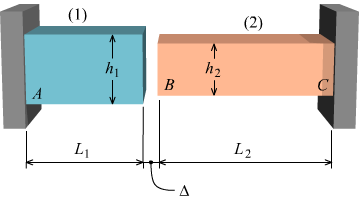At a temperature of 60°F, a 0.04-in. gap exists between the ends of the two bars shown. Bar (1) is an aluminum alloy [E = 10,000 ksi; v = 0.32; α=α=12.5 x 10-6/°F] bar with a width of 2.5 in. and a thickness of 0.75 in. Bar (2) is a stainless steel [E = 28,000 ksi; v = 0.12; α=α=9.6 x 10-6/°F] bar with a width of 1.7 in. and a thickness of 0.75 in. The supports at A and C are rigid. Assume h1=2.5 in., h2=1.7 in., L1=31 in., L2=46 in., and Δ=Δ= 0.04 in. (A) Determine the lowest temperature, Tcontact, at which the two bars contact each other. (B) Find a geometry-of-deformation relationship for the case in which the gap is closed. Express this relationship by entering the sum δ1+δ2, where δ1 is the axial deflection of Bar (1), and δ2 is the axial deflection of Bar (2). δ1+δ2= _____in. (C) Find the force in the Bar (1), F1, and the force in Bar (2), F2, at a temperature of 225oF. By convention, a tension force is positive and a compression force is negative. IN KIPS (D) Find σ1 and σ2, the normal stresses in Bars (1) and (2), respectively. By convention, a tension stress is positive and a compression stress is negative.
At a temperature of 60°F, a 0.04-in. gap exists between the ends of the two bars shown. Bar (1) is an aluminum alloy [E = 10,000 ksi; v = 0.32; α=α=12.5 x 10-6/°F] bar with a width of 2.5 in. and a thickness of 0.75 in. Bar (2) is a stainless steel [E = 28,000 ksi; v = 0.12; α=α=9.6 x 10-6/°F] bar with a width of 1.7 in. and a thickness of 0.75 in. The supports at A and C are rigid. Assume h1=2.5 in., h2=1.7 in., L1=31 in., L2=46 in., and Δ=Δ= 0.04 in.
(A) Determine the lowest temperature, Tcontact, at which the two bars contact each other.
(B) Find a geometry-of-deformation relationship for the case in which the gap is closed. Express this relationship by entering the sum δ1+δ2, where δ1 is the axial deflection of Bar (1), and δ2 is the axial deflection of Bar (2). δ1+δ2= _____in.
(C) Find the force in the Bar (1), F1, and the force in Bar (2), F2, at a temperature of 225oF. By convention, a tension force is positive and a compression force is negative. IN KIPS
(D) Find σ1 and σ2, the normal stresses in Bars (1) and (2), respectively. By convention, a tension stress is positive and a compression stress is negative.
(E) Determine δ1 and δ2, the deformations of Bars (1) and (2), respectively. By convention, a deformation is positive for a member that elongates, and it is negative for a member that is shortened.
(F) Determine εlat1,T, the component of the lateral strain caused by the temperature change.

Step by step
Solved in 5 steps









